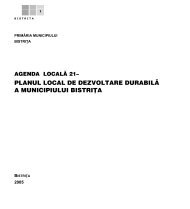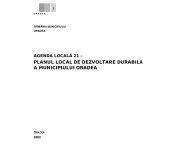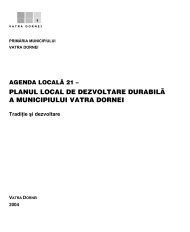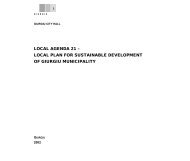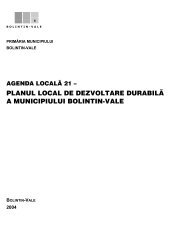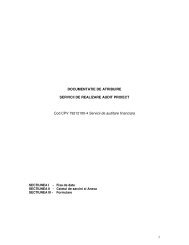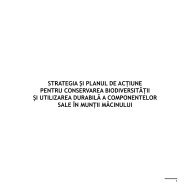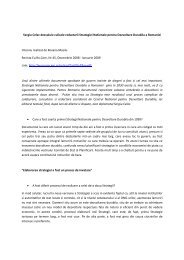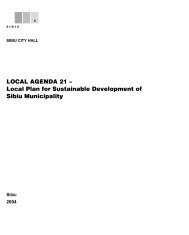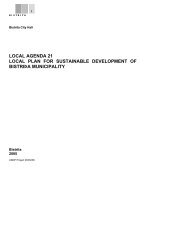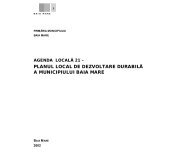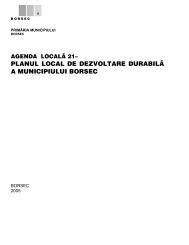English Version - United Nations Development Programme Romania
English Version - United Nations Development Programme Romania
English Version - United Nations Development Programme Romania
Create successful ePaper yourself
Turn your PDF publications into a flip-book with our unique Google optimized e-Paper software.
Unfortunately, we can also observe a decline in the field of forestry, visible in the decrease of<br />
the volume of forestry works: regeneration, care, protection, ecological rebuilding of stands and access to<br />
the forest fund, due to lack of financial resources.<br />
Activities of restocking the degraded lands and of planting protective forest belts were practically<br />
abandoned, while: a) water erosion expands to over 7 million ha (out of which 2 million hectares are<br />
seriously affected by erosion) and wind erosion affects 0.4 million ha; b) excessive dry periods are<br />
frequent on 7 million ha; c) landslides affect 7 million ha; d) there are 2,150 hydrographic basins showing<br />
a tendency towards extremely heavy rains. These man-made processes tend to accelerate.<br />
In addition to all the listed factors, there is a delay in implementing the real reform and the<br />
institutional restructuring of the forestry industry, as well as in the adoption of a forestry legislation<br />
harmonised with European law. Financial problems, poverty of the rural population and the lack of forest<br />
awareness are further causes that obstruct the sustainable management of forests. There is no strong<br />
political lobbying for the protection and sustainable development of forests, as politicians demonstrate a<br />
keen interest only in forestry exploitation and in reinstalling property rights, but very little in their<br />
sustainable management. The Parliament and the political partie s do not do anything to increase public<br />
awareness concerning the fundamental importance of forests in (I) protecting the ecological balance of<br />
the country (II) the sustainable development of the national economy and culture.<br />
b) Strategic actions leading to sustainable management of forests in <strong>Romania</strong><br />
Ensuring the integrity of the country's forests, by respecting the situation resulting after the changes<br />
in the law on ownership and with full observance of the said law. To achieve this, it is necessary to<br />
introduce new legislation banning the reduction of forest area under any circumstances, with certain<br />
exceptions, of course, and with the approval from superior echelons. Special attention must be paid to<br />
the conservation of the forest vegetation that is located outside the forestry fund and also to the<br />
currently endangered forests called “forested pasturelands,” whose area is in excess of 400,000<br />
hectares.<br />
Restocking of the forestry fund to the optimum level of 35% of the country's territory (with regional<br />
differences: 10% in the plains, 25% in the hilly regions, 65% in the mountainous area), phased as<br />
follows:<br />
Levels 1999 2010 2020 Long term<br />
Forested Areas<br />
(% of country area) 26.7 28 31 35<br />
The means by which this objective can be attained are the following:<br />
* Afforestation of degraded and abandoned agricultural lands (65,000 ha until 2010 and<br />
300,000 ha until 2020);<br />
* Creation of protective forest belts and anti-erosion shelter belts (2,000 km until 2010 and<br />
10,000 km until 2020);<br />
* Creation of green belts around cities and towns, as well as watercourse regulation in the<br />
case of streams (2,500 km of stream network until 2020).<br />
Ecological rebuilding of forests structurally damaged by natural and human-related factors; this will<br />
include forest re-naturalisation of some areas in the along the course of the Danube and of some<br />
interior rivers. This will be extended gradually to almost 20,000 hectares annually during the period<br />
2000-2010 and to 30,000 hectares annually during the period 2010-2020.<br />
Limitation of the volume of annual wood exploitation to the forests capacity level (16-16.2 million<br />
m³/year. In the period 2000-2010 and 16.5-17.5 million m³/year in the period 2010-2020). The<br />
mechanical and chemical wood processing industry will be adapted to meet these parameters, and so<br />
with wood exportation. The export of unprocessed wood and of only slightly processed wood<br />
products is damaging for the national economy.<br />
In order to put to better use the resources offered by forests, it is necessary to build roads in order to<br />
facilitate access to the 2 million hectares of mountain forests which are presently inaccessible, with<br />
the following dynamic phasing:<br />
Levels (years) 1995 2000 2010 2020<br />
Roads(m/hectares) 6.2 6.3 7.5 12.0<br />
The necessary funds for this process (around 50,000$/km) will be generated by many sources: selffinancing,<br />
national budget, international financial support.<br />
34



